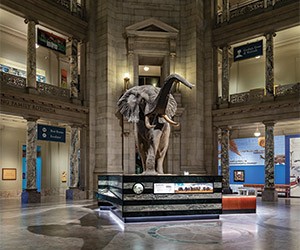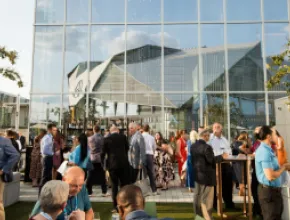On Nov. 8, the eyes of the world will be on Washington, D.C., when voters head to the polls for the U.S. presidential election. As political theater goes, needless to say, the contest to become America’s 45th president so far has been a show for the ages.
For drama of another stripe entirely, D.C. offers a jewel box of museums, theaters, entertainment venues, galleries and other stages. With a flourish of new hotels and new cultural landmarks opening this year, plus multiple milestones for key venues and organizations, D.C. is ever more a global capital of inspiration.
“We are as excited about the volume of soon-to-open hotels and cultural institutions as we are the number of arts-related anniversaries in 2016,” stated Elliott Ferguson, president and CEO of Destination DC, in a preview release.
Some $9.2 billion in neighborhood redevelopment projects—roughly equal to current investments being made in Las Vegas—is changing the personality of D.C. Citing events such as this fall’s debut of the National Museum of African American History and Culture, Ferguson also noted “what a compelling living classroom our city can be,” adding that, “coupled with exciting nightlife and unique retail, D.C. is the place to be in 2016.”
For artistic and cultural engagement, putting D.C. and neighboring Northern Virginia on the group ballot is a measure for success.
National Treasures
Amid the election year buzz, anticipation is also high for the slated September opening of the National Museum of Afri can American History and Culture. Representing the final Smithsonian Institution museum to be built above ground on the National Mall, the 400,000-square-foot building is set on five acres by the Washington Monument and other landmarks. With four stories below ground and four above, the museum will present the span of the African-American experience in America via some 34,000 artifacts. Meeting spaces will include the 350-seat Oprah Winfrey Theater.
The Smithsonian Institution, the world’s largest museum and research complex, now comprises 17 Washington, D.C., metro-area museums and galleries, plus the event-capable National Zoological Park, where giant panda cub Bei Bei debuted in January.
Established in 1846, the same year as The Smithsonian Institution itself, and in its present building since 1910, the adjacent National Museum of Natural History features an Easter Island statue and infamous Hope Diamond among its 126 million-object collection, the largest in the world. Transformation of the three-story west exhibition wing continues this year, with The Nation We Build Together opening this summer and American Culture opening next summer.
One of the world’s most visited museums, the venue is among several Smithsonians available for after-hours special events, most requiring a “co-sponsoring” unrestricted contribution from the participating corporation or organization. Others include the ever-popular National Air and Space Museum, which celebrates its 40th birthday in 2016 with the reopening of the Boeing Milestones of Flight Hall; American Art Museum and National Portrait Gallery; National Museum of the American Indian; and stately Smithsonian Castle.
Preeminent non-Smithsonian venues include the free-admission, tour-capable National Gallery of Art, which turns 75 this year. In September, the museum is scheduled to reopen its East Building following a $30 million, three-year renovation. Featuring exceptional theater space, the building has added more than 12,000 square feet of art space and a rooftop sculpture garden overlooking Pennsylvania Avenue.
Blowing out 60 birthday candles in 2016 is the Washington National Opera, while The Washington Ballet closed out its 40th anniversary season in May. With the National Park Service celebrating its centennial this year, the lovely U.S. Botanic Garden on the Mall is hosting the living Flora of America’s National Parks exhibition through Oct. 2. Set on five acres of landscaped gardens, Federal-style Tudor Place, Georgetown’s premiere decorative arts museum and historic house, marks its 200th anniversary throughout 2016.
Housed in a Renaissance Revival building three blocks from the White House, the National Museum of Women in the Arts is the only museum in the world dedicated exclusively to women artists. One year shy of its 30th anniversary, the museum is also a highly sought-after meeting and reception venue, with versatile space, including the marble-clad Great Hall and Mezzanine and fifth-floor, 200-person-capacity Performance Hall.
PageBreak
Second Stages
Washington’s cultural abundance extends to less-traditional venues, such as the House of Sweden.
Providing a unique minimalistic Scandinavian environment in the heart of Georgetown, this masterful building, also serving as the Swedish embassy and cultural and business center, offers more than 12,000 square feet of high-tech space for up to 500 guests. With sweeping views of the Potomac, Kennedy Center, Air Force Memorial and Watergate Complex, versatile venues include Anna Lindh Hall, with movable glass panels and rooftop terrace, Alfred Nobel art gallery and exhibition hall, and dynamic conference rooms.
Predating Harlem’s legendary Apollo Theater, the Howard Theatre (1910) was once the heart of D.C.’s “Black Broadway,” featuring legends like Ella Fitzgerald and D.C. native Duke Ellington. Shuttered in the 1980s, this revered landmark was revived in 2012 and anchors the eclectic Shaw neighborhood. Along with live entertainment, the Howard, with a stellar sound system, hosts meetings, seated events and cocktail receptions for up to 800 people. Also in Shaw, directly across from the Walter E. Washington Convention Center, Long View Gallery flexibly hosts from 25 to 500 guests for dinners and receptions.
On D.C.’s Southwest Waterfront, Arena Stage at the Mead Center for American Theater features three theaters under one roof, enclosed by a 56-foot glass wall. Offering nearly 15,000 square feet of space, the venue is a classic choice for galas, board meetings, corporate events and more.
In Northeast D.C., the 2012 revival of historic Union Market from 1931 features nearly 40 independent food vendors and dining concepts. Above the marketplace, Dock5 is a unique 12,000-square-foot blank canvas event venue with 22-foot ceilings. The space, which extends into an outside dock and private alley, can host up to 1,000 people.
Virginian Variety
Fanning out across the Potomac River west of D.C., Northern Virginia is also for lovers of art and culture. Home to some 55 arts organizations and 1,500-plus annual arts-related events, second only to D.C. itself, Arlington has been declared “a hotbed of cultural abandon” by The Washington Post.
Among several group-capable venues and galleries managed by the Arlington Cultural Affairs division is the 387-seat Rosslyn Spectrum Theatre. Along with live music and theater, this versatile space is available for daytime meetings, conferences and other gatherings, with some evening and weekend availability.
Nationally renowned for its cultural scene is Alexandria, which Brooklyn, N.Y.-based collaborative agency ArtPlace America named one of the nation’s top ArtPlaces in 2013. Event-capable stars include the Torpedo Factory Art Center, originally a WWI-era torpedo manufacturing facility transformed into an artistic hub in 1974. Filled with artists’ studios and galleries, the three-level venue is the consummate canvas for after-hours functions. For both performances and group gatherings, other top coordinates include the legendary concert venue Birchmere Music Hall and the 130-seat MetroStage.
The Smithsonian’s story continues in the Fairfax County town of Chantilly, where the sprawling Steven F. Udvar-Hazy Center is the sister site to the National Air & Space Museum on the National Mall. Housed in two enormous structures, the Boeing Aviation Hangar and James S. McDonnell Space Hangar, the free-admission, group-capable facility showcases myriad aviation and space artifacts, such as the Space Shuttle Discovery. Popular, too, is the Donald D. Engen Observation Tower, providing sweeping 360-degree views of Washington Dulles International Airport and its environs.
Celebrating its 50th season this year, Wolf Trap National Park for the Performing Arts in Vienna stages 100-plus live performances across all genres during the summer. Partnered with the National Park Service, the 117-acre park, featuring the striking Filene Center and intimate Children’s Theatre-in-the-Woods, is open for year-round recreational opportunities.
Cultural coordinates in Loudoun County, D.C.’s scenic wine and horse country, include the Tally Ho Theatre and Loudoun Symphony Orchestra, both in Leesburg; National Sporting Library & Museum in Middleburg; and Franklin Park Arts Center in Purcellville.
Heading south into Prince William County and Manassas, group draws include the National Museum of the Marine Corps, Hylton Performing Arts Center, and the area’s largest outdoor concert venue, Jiffy Lube Live.
In Fredericksburg, halfway between D.C. and Richmond, the cultural centerpiece is the 400-plus seat Riverside Center, offering 36,000 square feet of performance and conference space, and programs including the Riverside Dinner Theater.







